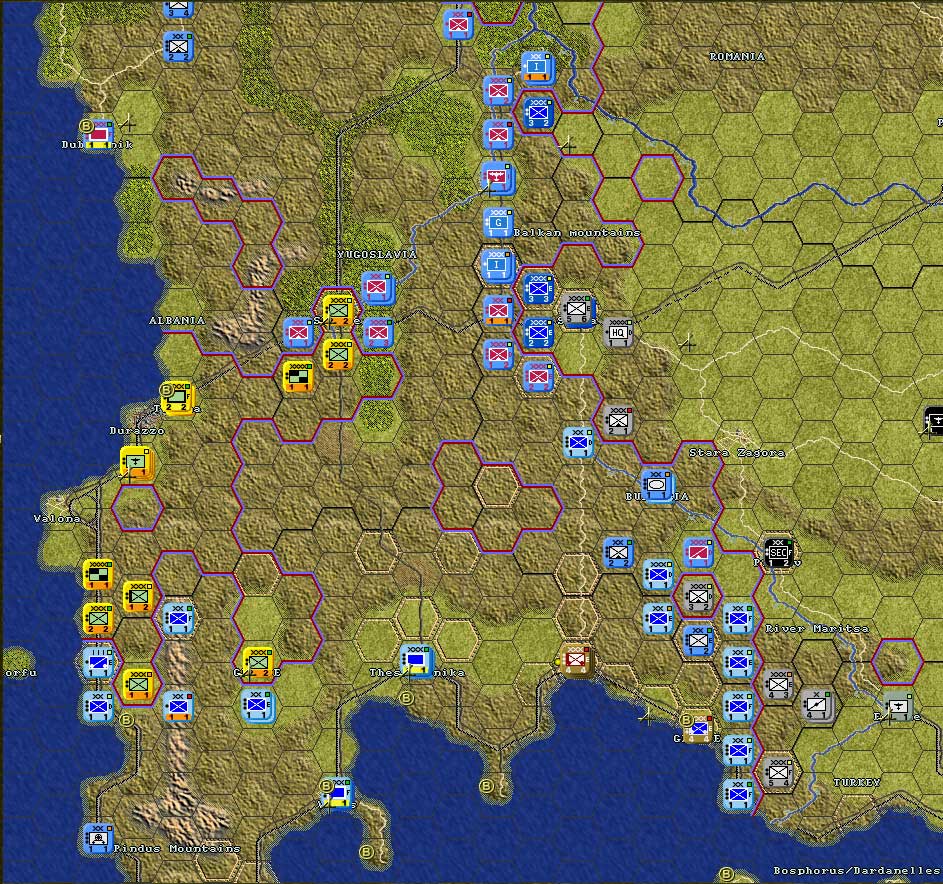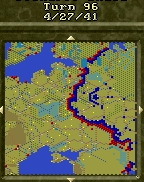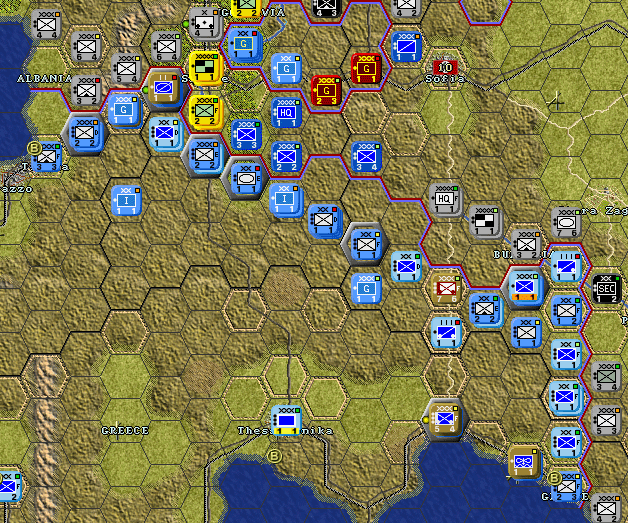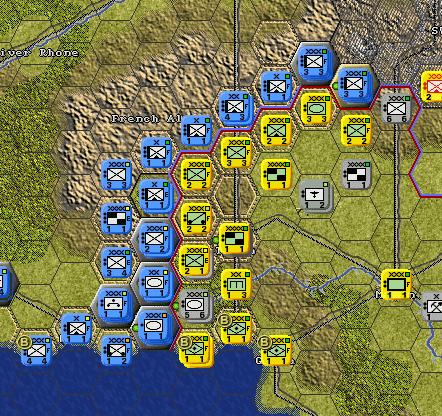
Write Up of the Continuing Europe Aflame Campaign
Played by Dura Price and Faron Bell
*See also, Duri's story
Let me begin this article by saying that I have not had this much fun wargaming in years. I love the old classic monster games; Europa, Pacific War, etc.. The only problem was actually trying to play out that two thousand counter monstrosity sprawled out across two sheets of plywood in your garage. Those paper games seldom saw more than the first year's worth of game time fought through. One of the players would move, the kids would come by and knock off several map feet of counters or maybe the local rules lawyer would throw a walleyed fit and the game would come to an end rather abruptly. Been there? Finally, we have a decent PC wargame engine and a really well done scenario that allows us to recapture that same 'ole excitement of a strategic, theater level simulation. No fuss, no muss, just pure grognaring fun.
I ran across the Europe Aflame (EA) scenario on "The Gamer's Net" website in v1.0 form. I immediately began to salivate after downloading the campaign (I will refer to this as a campaign...it's just to massive to be a scenario) and seeing the eons of detail. I had looked at a few other theater level WWII scenarios and always came away being disappointed with the non- historical unit composition, scale or some other aspect of the scenario that had been totally abstracted. I must say that Ulver and Mark must have made EA a full time job over the last year or two. The detail that I had been looking for was all here!
I quickly began searching all available 'net databases and came up with a few e-Mail addresses of Gamers that I thought might actually commit to playing the full 350 turns out or at least follow through to a reasonable conclusion. Enter Duri. I knew that Duri was a kindred spirit when he immediately returned my e-Mail and offered to go out and buy the same version of TOAW that I had. Being a pauper, I could not afford COW at that point in time. So, being the high powered and highly paid business executive that he is, Duri secured a copy of WotY and we were set. By the time we were ready to begin, v1.2 was available. The sides were set up with Duri as Axis and I (mild mannered and peaceful in nature) as Allies. We were then all set to begin the most challenging and enjoyable wargame that I can remember in recent times.
Turn 1 - 4: I approached this game having already played about 30 turns into another EA v1.1 scenario as the Axis. Duri had never played EA before. Thus I had some knowledge of how powerful the Axis could be in the first half of the game. I wanted to protect France from an quick capitulation and selected the Maginot line option, figuring that Duri would attack Poland on turn 2, as I had done in my game as Axis. Duri opted for the Pre-war builds, Axis Carriers and ultimately the German West Wall. Little did I realize, Duri's eyes were looking East. As the Russian's, I occupied Bessarabia figuring that Duri would be busy munching on the Poles. By turn 4, I had sufficiently ticked off the Rumanians, Hungarians and Bulgarians so as to push them into the loving arms of the Axis. This was to leave Greece alone, joining the Allies. The Axis and new found friends persuaded the Poles into an expedition featuring, "The Russians for lunch bunch," with the Finn's joining in for grins. Much to my dismay, the stage was set for an Eastern Crusade Variant of EA. I had figured my Allied strategy towards a more traditional Axis campaign. I had figured wrong.
On Turn 1, I had begin moving masses of Russian troops toward Finland for a Winter War in the summer. By Turn 2, I realized that things were not quite what they seemed and began shifting troops back into line. I was part way through the transition when, on Turn 4 (July 22, 1939), the Axis and their minions began the invasion of Russia. By turn 4, I had already invaded the Baltic States and had gleaned the extra Northern Soviet Border units in addition to the units gained by the Bessarabia incursion. This would help slow the Axis advance while the Russians formed a line of battle along the Dvina River in the North, anchored by Riga and along the Dneister in the South. The Russians began to dig like moles.
Turn 5-20: After a period in the North, the Axis shifted most of their armor and motorized formations to the South. This was to be Duri's strategy (unknown to me until turn 50 or so), a limited Northern and Central advance so as not to trigger the Allied option for war, coordinated with an all out Southern attack that would secure the Caucus oil rich region and Stalingrad, before turning towards Moscow. The Dneister River line was quickly penetrated when the Axis found a hole in the Russian line behind the super river. German Engineers were used for a quick crossing and the Russian line was compromised in a snap. The Russians sacrificed several Corps in an holding action around Odessa while the bulk of the Southern Army escaped behind the Bug and ultimately, the Dneiper. The city of Kiev anchored the Southern line and was quickly engaged. A fierce battle ensued for several weeks but the city fell on Turn 17 (October 7, 1939).
Meanwhile Riga had fallen on Turn 13 and a slow Axis advance was made in the North towards Estonia. The Finns had begun the conquest of the Northern reaches and were threatening Murmansk (fell on Turn 21) by November of '39. The Russian line solidified along the Dvina thru Mogilev and East of the Pripet Marshes, thru Gomel and Chernihev, along the Dneiper and finally anchoring on Melitopol. Unfortunately the Axis had invested the Sevastapol region about the time winter had set in. Although this period saw significant Russian losses and set backs, all large scale Axis penetrations had been avoided.
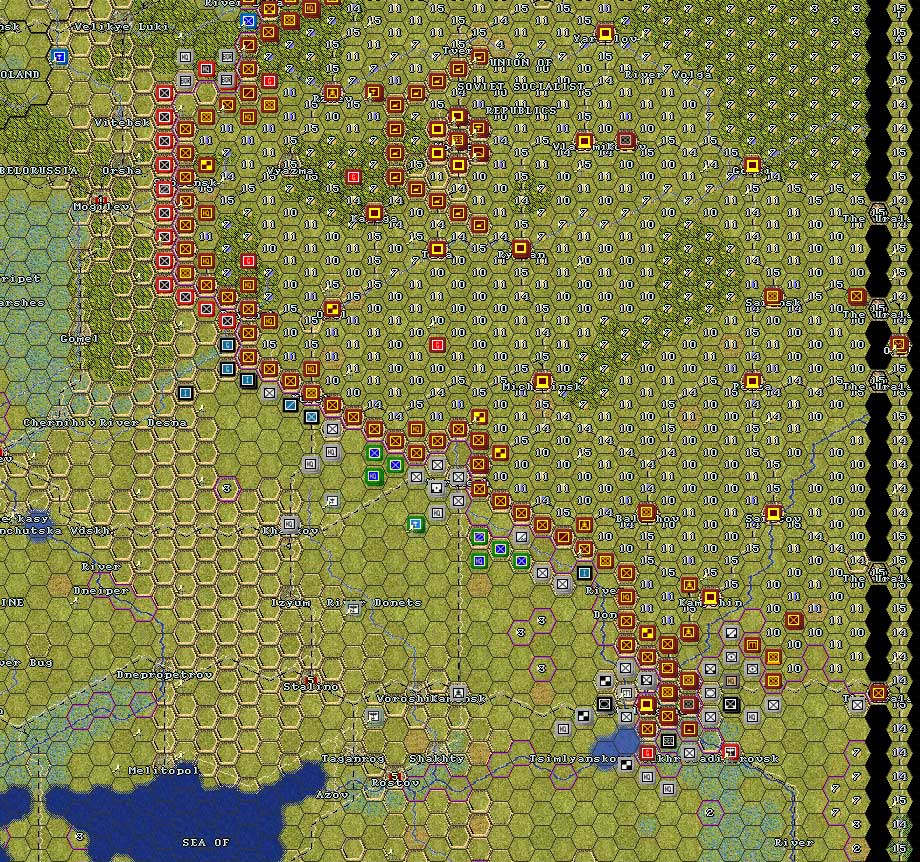
Turn 76: An overview of the Eastern Front.
Turn 21-36: After the fall of Murmansk, the Russian supply level had dropped significantly enough to began hampering the recovery of the battle fatigued troops. Fortunately for the brave but battered Russian Army, four waves of reinforcements had made it to the front to off set sudden holes appearing all to often in the otherwise stalwart Russian line. Time and time again, I was amazed to see reinforcements show up about the time I thought that there was no possible way to plug the ever widening gaps and bulges in the Russian lines. I had been pushed back, but my line had not been compromised. Though I sacrificed the occasional infantry corps, no large scale encirclements had occurred. My biggest gamble and mistake to date came when, in desperation, I assaulted Murmansk via a sea landing with a French Expeditionary force. I retook the city but the valiant French unit was annihilated the following turn.
The major problem for the Russians at this point was that the Axis were threatening the Kerch Straits and had encircled Sevastapol. I withdrew to Kerch and began digging in along the causeway and on the shoreline outside of Novorossik, in the Caucus region. I felt confident that I could withstand a major offensive into this area. I was to be sadly disappointed.
In the Northern area of operation, the Finns and a German Infantry Corps threatened Leningrad. I had intentionally placed my best motorized and mechanized units in this region to defend against any possible thrust towards that important supply point. Unfortunately, Axis success in taking Riga and Murmansk had stripped valuable units away from Leningrad. I believed I could hold Leningrad with the garrison plus three infantry corps dug in and fortified. Again, I would be sadly mistaken.
The Russian air and naval units were in a sorry state. I had long ago withdrawn the few air assets I had remaining to Moscow for recovery. The Russian Navy had piecemealed into action and all but one fleet had been destroyed.
Mercifully, the Russian winter set in and a cease fire occurred between Turn 26 thru 36. The Russians infantry used this time to dig entrenchments up to 125 km in depth and beyond (3- 5 hexes) in order to fall back during the Axis Spring offensive that was sure to come. The Russians also were able to adjust their lines and assemble limited reserves in critical areas.
Turn 37 - 48: February 24, 1940 saw the opening of the true Barbarossa Spring Axis offensive (declared March 3rd). I had prepared for the assault to the best of my ability and felt confident that I could slowly withdraw to Stalingrad with a largely intact army while holding at least Baku, in the Caucus region. I had rested and reinforced my troops in critical places and even managed to assemble a small reserve near key points in the line. Enter the Kerch Straits.
Sevastapol had been evacuated prior to winter, with only a token garrison remaining. The ancient fortress city fell on Turn 36, the first week of spring. The Axis quickly advanced on Kerch and the gateway to the Caucus region fell on March 3rd. Using a surprise airborne assault near Novorossik, the Germans were able to cross the straits and threaten this important anchorage. The Russians contained the German intrusion to just a few hexes in depth and being ever optimistic, I believed Duri would have a long hard road to Maikop and Grozny.
The Axis had captured Dnepropetrov prior to the winter cease fire and slowly advanced on Stalino and Rostov. I threw everything I had into the Southern fray in hopes of keeping Duri from investing Rostov, but he was making slow progress, hex by hex, but advancing nonetheless.
The Northern sector was relatively quiet. The Rumanians posted there were not strong enough to engage the fortified Russian line. Only occasionally, would a brisk skirmish ensue with very limited Axis gains in the North and Far North regions. The tradeoff was that the Far Northern and Central areas had consumed a great deal of resources that could have been used and were desperately needed in the South. Enter the second disaster of the game (the first being the loss of Murmansk), Leningrad.
As stated previously, I had sent some of the units guarding Leningrad to the West for the defense of Talinin and into the Far North, just South of Murmansk. I had and continue to have an obsession with the Axis breaking thru the Far North Front and rushing downward towards Moscow. With only three Russian Infantry Corps and the Leningrad Garrison guarding the city, Duri decided to risk a direct assault. He was successful and took Leningrad in just one turn of fighting. Desperate Russian counterattacks ensued and the city was retaken but fell again the following turn. By May 12, 1940 it was firmly under the occupation of several Finn and one German Corps. This was a crushing blow to the Soviet war machine and would also see the Swedes join the Axis in their Russian endeavor. Supply resources fell to a level of '18', meaning that Russian units would have an even tougher time recovering from fatigue and reducing overall troop effectiveness substantially. Novorossik in the Caucus region had fallen April 7 (Turn 43), so this was a particularly bitter pill to swallow. Mercifully, the Axis Barbarossa shock advantage ended the same turn as the fall of Leningrad.
Still, even with the loss of Murmansk and Leningrad, the Russian line had held. Only local penetrations had been made into the defenses and these were quickly sealed off by meticulous withdrawal and the careful use of reserves. Little did I know, that the Russians were about to begin the most trying time of the campaign to date.
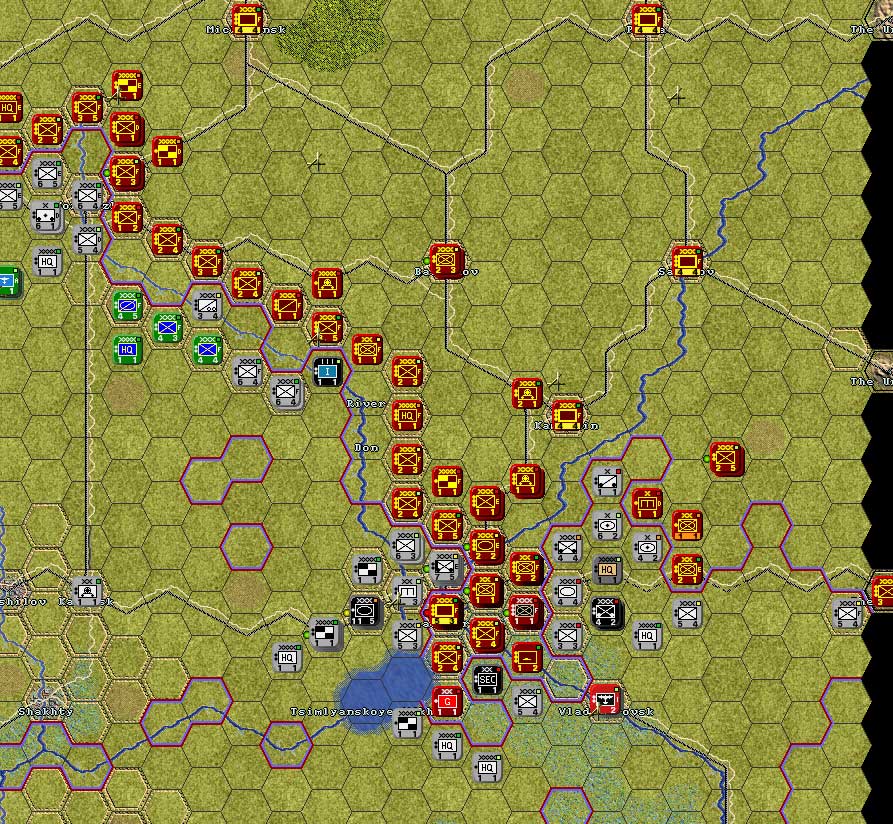
Turn: 76: A closer look at the battle for Stalingrad.
Turn 49 - 68: With the loss of Leningrad and later, Talinin (Turn 59/July 28), the Northern Front settled down to a stalemate. The Russians held a solid line behind the Volkhov River anchored by the city of the same name. The Axis had been very cautious in the Central sector to hold back so as not to trigger the entry of the French and British.
Meanwhile, on the Southern Front things began to disintegrate rather rapidly. Novorossik had fallen in early April but the Axis had been contained in the treacherous and difficult mountain region just north of Krasnodar. Duri had been able to "inch" his way towards Stalino and Rostov. Both cities had been overrun by June 23 (Turn 54) and the Caucasus region was blown wide open.
Massing all available armor and motorized units in his vast inventory, Duri began a steady advance Southward toward Maikop and the Central plains. As the lines bulged and grew ever longer, my Russian resources were stretched to the limit. I had thrown in every available unit to plug the increasing penetrations. Finally by late July, Duri had made the first and only (to date) irreparable gap in the Russian line. Several panzer and motorized corps opened a 75 km wide gap and enveloped the central Caucasus plains region. This spelled disaster for the oil rich region. [See Duri's wonderful work of fiction, 'Nichevo', based on these events]
To make matters worse, the Axis had landed paratroops and seaborne assault infantry into Batum. Desperate air assaults ensued as I moved all my available airpower into the region South of Maikop and near Grozny to repel the German intruders. Although the brave Russian Air Corps inflicted heavy losses on incoming seaborne troops, I was unable to stop the invasion and Batum fell on July 14 (Turn 57). This desperate air counter attack cost me about 500 aircraft and the air units were once again withdrawn to Moscow for refitting.
I was faced with withdrawing the remnants of the Southern Russian Armies towards the river South of Rostov or risk loosing 25% of the entire Russian Army, trapped in the Caucasus. Though, I managed to salvage the majority of the Southern Army, I lost six or more high quality infantry and motorized corps adding up to at least 500,000 men. This would be a devastating blow and the third great disaster in the campaign.
Once again, however, the Russian Army rallied and began to rebuild a line of defense South of Rostov along the river and anchored on the cities of Voroshilov and Shakhty, about 250 km West of Stalingrad. I sacrificed the already lost Caucasus region to the oil lusting Axis in order to buy time for my rally cry. Maikop, Grozny and Baku had all fallen by Turn 68 (September 28). Not only would this conquest deliver a huge cache of advanced German tanks into the Axis inventory, but the loss of Baku would bring Turkey into the war on the side of the Axis.
I finished this period in a state of depression. I had fought tooth and nail, done everything in my power to slow the German advance but yet still they came ever forward. I had now lost more light infantry squads than I had in action, close to 100,000 or almost 3 million men in game terms and had seen my supply level reduced to '14'. The only saving grace was that for the most part, I had saved my army from total destruction and had formed a solid, though much weakened, line near Stalingrad. Little did I know, that I was about to receive an unexpected and most pleasant surprise.
